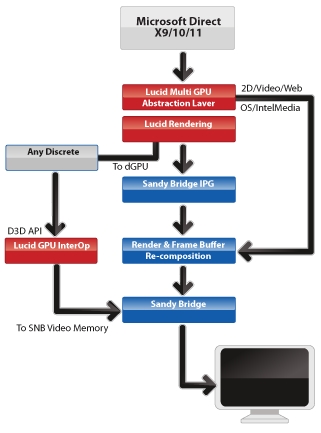
Gigabyte has announced that at least four of its forthcoming Z68-based motherboards will use LucidLogix’s Virtu software to combine Intel’s Sandy Bridge processor graphics unit (PGU) with any add-in GPU, creating an all-in-one 'virtual' GPU.
Lucid previously made a name for itself with the Hydra chip, which aimed to combine the power of any graphics cards, regardless of the manufacturer. However, the company's Virtu technology takes the form of software.
Lucid claims that the software ‘will dynamically balance the advanced power-efficient, built-in media features of the Intel Core processor graphics with the high-end, DirectX 11 3D, anti-aliasing and performance features of discrete GPUs, while significantly reducing the power drain of traditional entertainment desktops.’
The idea is that the software will take advantage of the media-centric capabilities of the Sandy Bridge PGU, which Intel claims is capable of encoding video faster and with less power consumption than mid-range discrete GPUs. This might sound unlikely, but it is plausible.
Intel uses fixed-function logic in the PGU that’s highly optimised for the task of video encoding while Nvidia and AMD rely on shoving the task through the general-purpose stream processor units of their GPUs to achieve the same result, which can be less efficient.
Our current understanding of Z68 is that its graphics system can operate in a hybrid fashion, enabling a power-hungry discrete graphics card to shut down completely while the PGU takes over basic Windows tasks.
However, the trick of the Virtu technology is make any transition from one graphics unit to the other seamless. According to Lucid, the Virtu software ‘is able to assign tasks in real time to the best available graphics resource based on power, performance and features considerations,’ while the display output is permanently routed through the Sandy Bridge graphics system. The company claims that the end result will be a fast PC that produces minimal heat and noise, while also reducing the power draw.
‘We are excited about our new partnership with Lucid because of the huge potential for switchable graphics in the PC DIY market, where Gigabyte motherboards enjoy considerable market share’ said Henry Kao, vice president of R&D at Gigabyte.
Are you excited by the prospect of virtual graphics, or are you happy with what you’ve got? Let us know in the forums.
Lucid previously made a name for itself with the Hydra chip, which aimed to combine the power of any graphics cards, regardless of the manufacturer. However, the company's Virtu technology takes the form of software.
Lucid claims that the software ‘will dynamically balance the advanced power-efficient, built-in media features of the Intel Core processor graphics with the high-end, DirectX 11 3D, anti-aliasing and performance features of discrete GPUs, while significantly reducing the power drain of traditional entertainment desktops.’
The idea is that the software will take advantage of the media-centric capabilities of the Sandy Bridge PGU, which Intel claims is capable of encoding video faster and with less power consumption than mid-range discrete GPUs. This might sound unlikely, but it is plausible.
Intel uses fixed-function logic in the PGU that’s highly optimised for the task of video encoding while Nvidia and AMD rely on shoving the task through the general-purpose stream processor units of their GPUs to achieve the same result, which can be less efficient.
Our current understanding of Z68 is that its graphics system can operate in a hybrid fashion, enabling a power-hungry discrete graphics card to shut down completely while the PGU takes over basic Windows tasks.
However, the trick of the Virtu technology is make any transition from one graphics unit to the other seamless. According to Lucid, the Virtu software ‘is able to assign tasks in real time to the best available graphics resource based on power, performance and features considerations,’ while the display output is permanently routed through the Sandy Bridge graphics system. The company claims that the end result will be a fast PC that produces minimal heat and noise, while also reducing the power draw.
‘We are excited about our new partnership with Lucid because of the huge potential for switchable graphics in the PC DIY market, where Gigabyte motherboards enjoy considerable market share’ said Henry Kao, vice president of R&D at Gigabyte.
Are you excited by the prospect of virtual graphics, or are you happy with what you’ve got? Let us know in the forums.

MSI MPG Velox 100R Chassis Review
October 14 2021 | 15:04









Want to comment? Please log in.